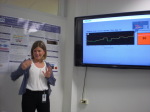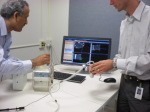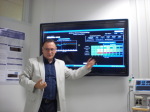Philips previews future med tech at N.Y. research outpost
June 28, 2012
By Brendon Nafziger and Loren Bonner
Charlie Smith - not his real name - never made it out of intensive care.
The 82-year-old patient died after his blood pressure plummeted, a condition known as hypotension that affects up to a quarter of patients in the ICU, and can lead to organ failure.
But at a research facility an hour's drive north of New York City, engineers are developing a predictive algorithm they say can score patients based on likely pressure-drop risks. With the scores, doctors in the ICU might be able to intervene earlier.
The technology is just one of at least four in-the-works health care projects Royal Philips Electronics is cooking up at a Philips Research outpost in Briarcliff Manor, N.Y. DOTmed News toured the facility last week.
Research campus
The leafy campus, whose interior somewhat resembles the science wing of a mid-century high school, dates back to the 1940s, when Philips executives briefly transferred much of the company's control to a U.S. subsidiary to preserve its independence during the German occupation of Holland.
Now the Westchester county office, along with sites in Massachusetts, Europe and Asia, is one of the half dozen facilities that the Dutch giant relies on to come up with new inventions to "meet unmet needs" in the marketplace, according to Philips Research's general manager, Henk van Houten.
As with other technology-driven companies, employees are given some creative playtime. Every Friday afternoon, for instance, engineers can tinker on their own projects, which are later shared at an annual Eureka Fair. Airfloss, a recently released consumer product that cleans out dental plaque with blasts of air and water instead of waxy tape, came out of one of these meetings, according to Van Houten.
Focusing on health
While the campus is not only focused on health care research, Philips increasingly is. Though perhaps best known for its lighting -- Philips is the biggest maker of light bulbs in the world -- the company says health care products, such as MRI scanners and patient monitors, now account for the heftiest chunk of its sales. According to slides shared by the company, 40 percent of its nearly 23 billion euros ($29 billion) in revenues last year came from its health division, 34 percent from lighting, and 26 percent from its consumer lifestyle wing, which makes things like electric razors.
"Philips is now really a health and wellbeing company," Van Houten said.
The company has ambitious plans for its health care section. By 2015, it intends for half a billion people to have used or benefited from a Philips medical product, such as getting a scan on a Philips imaging unit or having vital signs read on a Philips monitor.
But one area of special focus is cancer, according to Van Houten. "We don't think we can cure cancer," he said, "but we believe we can make therapy delivery so much more precise to reduce side effects."
During DOTmed's tour, Philips showed the news team two experimental products in the precision-therapy for cancer category, in addition to two clinical decision support prototype programs.
Planning liver cancer treatments
One potentially precision-improving technique shown to DOTmed News is a software program that could tweak the accuracy of a kind of minimally invasive liver cancer treatment that uses heat-generating needles.
In this technique, a doctor guides a needle into a liver tumor, aided visually by ultrasound and CT scans. When the needle sticks into the tumor, the doctor presses a button, opening the needle's endpoint into a fan of thin tines. These in turn emit high-intensity radiowaves that heat up and burn away cancerous tissue, potentially destroying the tumor.
While the treatment works well on smaller tumors, it's trickier for lesions larger than 4 centimeters, according to Jochen Kruecker, project leader with interventional oncology guidance at Philips Research. For bigger growths, doctors have to perform multiple insertions, and therefore burns, to destroy all the malignant tissue.
"It's very difficult to do just by mentally considering where you have to go and track where you are (in the liver)," he said.
To better plan treatments, Kruecker said his team's program automatically creates optimal positions where doctors should place different insertions in order to cover the entire tumor. The plans are self-correcting, too: if a doctor misses the target, represented by a crosshair on the real-time ultrasound of the area, the software adapts the plan, to ensure that after all the burns the entire tumor is zapped.
Listening for blue dye
The second cancer-tracking technology involves an investigational technique that helps doctors find lymph nodes for biopsies in women with breast cancer.
"Clinicians told us we need something that is less invasive," said Ladislav Jankovic, a senior researcher at the research center.
In a normal lymph node biopsy, doctors have to cut open patients to identify and remove lymph nodes that might indicate where breast cancer has spread. A blue dye, which is injected into a patient's system beforehand, will mark the lymph nodes most likely to contain cancer cells, known as sentinel lymph nodes.
Jankovic said the purpose of the technology is to reduce the need for surgical biopsy and the side effects that can result. The experimental system is based on photoacoustic imaging, which can locate the sentinel lymph nodes and help guide a needle to the nodes to remove cells for further testing.
Like an ultrasound scan, a probe directs sound waves to a specific area, in this case the breast. But the photoacoustic system also integrates a laser into the ultrasound scan. Laser light is directed onto the underarm region and is absorbed by the dye that is injected into the patient's breast, and which diffuses into the lymph nodes. The nodes then expand and generate an ultrasound signal that's detected with the scanner, so doctors can guide the needle without opening up the flesh.
This imaging technique is in clinical testing at Washington University in St. Louis.
Clinical decision support
In addition to working on cancer treatment delivery helpers, Philips has other teams trying to develop tools to help doctors make better decisions, known as clinical decision support.
One of these is the hypotension prediction algorithm mentioned earlier, known as the hemodynamic instability indicator. This creates a score, between 0 and 100, based on vital signs, patient age and even updated lab reports, that indicates a patient's risk for critically low blood pressure. Currently, the technology's in the testing stage. But Philips researchers said they'll soon bring it into the hospital to see how physicians use the information and, eventually, whether it helps cut mortality rates. "We are going out to clinical study at five sites, not yet determined, in October," said Abigail Flower, project leader for the technology.
Another, similar clinical decisions support project, this time in the area of cardiopulmonary medicine, also aims to give clinicians prediction scores for at-risk patients -- in this case, for those who could suffer from acute lung injury, or ALI. The score is based on six data mining and knowledge-based algorithms, such as patient history and various parameters already available in the ICU, which can predict if a patient has developed ALI.
The condition develops when the thin lining of the lung breaks down. Since this limits the lung's ability to supply the body with oxygen, it can quickly progress into organ failure and even death.
The program, jointly developed with Mayo Clinic researchers, was installed at Mayo's METRIC Laboratory for testing. Nicolas Chbat, principal member research staff at Philips Research North America, said in the next month they will be receiving feedback to see what kind of work still needs to be done.
Chbat and his team hope these prediction scores will give clinicians a way to detect the condition early, ultimately helping to save more patients' lives. However, he cautioned that the technology only provides guidance to doctors. "We do clinical decision support, not clinical decisions," Chbat said.
Which ones will see the light of day?
Many of these projects have taken several years to progress from novel concept to physical systems that can be tested. What are their chances of success? Van Houten said he'd be "surprised" if fewer than three of the four products fail to get commercialized.
But besides these products that are inching closer to the market finish line, Van Houten has been keeping his eye on some other technologies earlier in the development cycle.
Among the too-soon-to-be-shown diagnostic and treatment technologies, Van Houten mentioned ultrasound on a chip; a "smart catheter," tipped by a transducer, to give real-time feedback during cardiovascular procedures; and spectral CT, which, he said, would be "like color photography after black and white."
Charlie Smith - not his real name - never made it out of intensive care.
The 82-year-old patient died after his blood pressure plummeted, a condition known as hypotension that affects up to a quarter of patients in the ICU, and can lead to organ failure.
But at a research facility an hour's drive north of New York City, engineers are developing a predictive algorithm they say can score patients based on likely pressure-drop risks. With the scores, doctors in the ICU might be able to intervene earlier.
The technology is just one of at least four in-the-works health care projects Royal Philips Electronics is cooking up at a Philips Research outpost in Briarcliff Manor, N.Y. DOTmed News toured the facility last week.
Research campus
The leafy campus, whose interior somewhat resembles the science wing of a mid-century high school, dates back to the 1940s, when Philips executives briefly transferred much of the company's control to a U.S. subsidiary to preserve its independence during the German occupation of Holland.
Now the Westchester county office, along with sites in Massachusetts, Europe and Asia, is one of the half dozen facilities that the Dutch giant relies on to come up with new inventions to "meet unmet needs" in the marketplace, according to Philips Research's general manager, Henk van Houten.
As with other technology-driven companies, employees are given some creative playtime. Every Friday afternoon, for instance, engineers can tinker on their own projects, which are later shared at an annual Eureka Fair. Airfloss, a recently released consumer product that cleans out dental plaque with blasts of air and water instead of waxy tape, came out of one of these meetings, according to Van Houten.
Focusing on health
While the campus is not only focused on health care research, Philips increasingly is. Though perhaps best known for its lighting -- Philips is the biggest maker of light bulbs in the world -- the company says health care products, such as MRI scanners and patient monitors, now account for the heftiest chunk of its sales. According to slides shared by the company, 40 percent of its nearly 23 billion euros ($29 billion) in revenues last year came from its health division, 34 percent from lighting, and 26 percent from its consumer lifestyle wing, which makes things like electric razors.
"Philips is now really a health and wellbeing company," Van Houten said.
The company has ambitious plans for its health care section. By 2015, it intends for half a billion people to have used or benefited from a Philips medical product, such as getting a scan on a Philips imaging unit or having vital signs read on a Philips monitor.
But one area of special focus is cancer, according to Van Houten. "We don't think we can cure cancer," he said, "but we believe we can make therapy delivery so much more precise to reduce side effects."
During DOTmed's tour, Philips showed the news team two experimental products in the precision-therapy for cancer category, in addition to two clinical decision support prototype programs.
Planning liver cancer treatments
One potentially precision-improving technique shown to DOTmed News is a software program that could tweak the accuracy of a kind of minimally invasive liver cancer treatment that uses heat-generating needles.
In this technique, a doctor guides a needle into a liver tumor, aided visually by ultrasound and CT scans. When the needle sticks into the tumor, the doctor presses a button, opening the needle's endpoint into a fan of thin tines. These in turn emit high-intensity radiowaves that heat up and burn away cancerous tissue, potentially destroying the tumor.
While the treatment works well on smaller tumors, it's trickier for lesions larger than 4 centimeters, according to Jochen Kruecker, project leader with interventional oncology guidance at Philips Research. For bigger growths, doctors have to perform multiple insertions, and therefore burns, to destroy all the malignant tissue.
"It's very difficult to do just by mentally considering where you have to go and track where you are (in the liver)," he said.
To better plan treatments, Kruecker said his team's program automatically creates optimal positions where doctors should place different insertions in order to cover the entire tumor. The plans are self-correcting, too: if a doctor misses the target, represented by a crosshair on the real-time ultrasound of the area, the software adapts the plan, to ensure that after all the burns the entire tumor is zapped.
Listening for blue dye
The second cancer-tracking technology involves an investigational technique that helps doctors find lymph nodes for biopsies in women with breast cancer.
"Clinicians told us we need something that is less invasive," said Ladislav Jankovic, a senior researcher at the research center.
In a normal lymph node biopsy, doctors have to cut open patients to identify and remove lymph nodes that might indicate where breast cancer has spread. A blue dye, which is injected into a patient's system beforehand, will mark the lymph nodes most likely to contain cancer cells, known as sentinel lymph nodes.
Jankovic said the purpose of the technology is to reduce the need for surgical biopsy and the side effects that can result. The experimental system is based on photoacoustic imaging, which can locate the sentinel lymph nodes and help guide a needle to the nodes to remove cells for further testing.
Like an ultrasound scan, a probe directs sound waves to a specific area, in this case the breast. But the photoacoustic system also integrates a laser into the ultrasound scan. Laser light is directed onto the underarm region and is absorbed by the dye that is injected into the patient's breast, and which diffuses into the lymph nodes. The nodes then expand and generate an ultrasound signal that's detected with the scanner, so doctors can guide the needle without opening up the flesh.
This imaging technique is in clinical testing at Washington University in St. Louis.
Clinical decision support
In addition to working on cancer treatment delivery helpers, Philips has other teams trying to develop tools to help doctors make better decisions, known as clinical decision support.
One of these is the hypotension prediction algorithm mentioned earlier, known as the hemodynamic instability indicator. This creates a score, between 0 and 100, based on vital signs, patient age and even updated lab reports, that indicates a patient's risk for critically low blood pressure. Currently, the technology's in the testing stage. But Philips researchers said they'll soon bring it into the hospital to see how physicians use the information and, eventually, whether it helps cut mortality rates. "We are going out to clinical study at five sites, not yet determined, in October," said Abigail Flower, project leader for the technology.
Another, similar clinical decisions support project, this time in the area of cardiopulmonary medicine, also aims to give clinicians prediction scores for at-risk patients -- in this case, for those who could suffer from acute lung injury, or ALI. The score is based on six data mining and knowledge-based algorithms, such as patient history and various parameters already available in the ICU, which can predict if a patient has developed ALI.
The condition develops when the thin lining of the lung breaks down. Since this limits the lung's ability to supply the body with oxygen, it can quickly progress into organ failure and even death.
The program, jointly developed with Mayo Clinic researchers, was installed at Mayo's METRIC Laboratory for testing. Nicolas Chbat, principal member research staff at Philips Research North America, said in the next month they will be receiving feedback to see what kind of work still needs to be done.
Chbat and his team hope these prediction scores will give clinicians a way to detect the condition early, ultimately helping to save more patients' lives. However, he cautioned that the technology only provides guidance to doctors. "We do clinical decision support, not clinical decisions," Chbat said.
Which ones will see the light of day?
Many of these projects have taken several years to progress from novel concept to physical systems that can be tested. What are their chances of success? Van Houten said he'd be "surprised" if fewer than three of the four products fail to get commercialized.
But besides these products that are inching closer to the market finish line, Van Houten has been keeping his eye on some other technologies earlier in the development cycle.
Among the too-soon-to-be-shown diagnostic and treatment technologies, Van Houten mentioned ultrasound on a chip; a "smart catheter," tipped by a transducer, to give real-time feedback during cardiovascular procedures; and spectral CT, which, he said, would be "like color photography after black and white."




